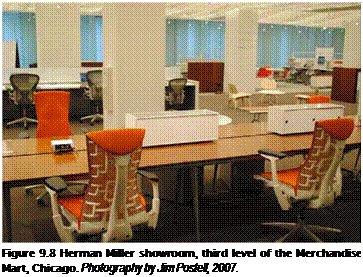Large furniture companies such as Fritz Hansen, Giogetti, Kartell, Knoll, Herman Miller, Vitra, and Zanotta have, to a degree, created and expanded new markets through the production of design goods (furniture produced and marketed as design items) (Figure 9.7). These companies differentiate themselves from other companies that produce period- replicated or conventional furniture. The furniture company Herman Miller uses design as a way to solve significant problems for people (Figure 9.8). This outlook, shared by other innovative furniture companies, places value on a pragmatic view in design, but this outlook is also tempered by the concern and awareness in the way furniture looks.
George Nelson was the director of design at Herman Miller for over 25 years and laid out five tenets of Herman Miller’s design philosophy:
1. What you make is important.
2. Design is an integral part of the business.
3. The product must be honest.
4. You decide what you will make.
5. There is a market for good design.
Large furniture companies employ distribution representatives, sales associates, and marketing directors, seeking ways to market furniture designs with contemporary building projects produced by architecture and interior design firms.
 Competition generates a reluctance to share technical knowledge and resources with others in the industry, making it difficult to develop a shared pool of information among professionals. This results in proprietary knowledge and techniques that are kept secret, resulting in intellectual property with patents protecting processes, finishes, innovative designs, and so on.
Competition generates a reluctance to share technical knowledge and resources with others in the industry, making it difficult to develop a shared pool of information among professionals. This results in proprietary knowledge and techniques that are kept secret, resulting in intellectual property with patents protecting processes, finishes, innovative designs, and so on.
Some furniture design companies market and distribute assembled products but outsource the fabrication of components and parts to others.
Interflex uses Mario Terraneo’s bottega in Meda,
Italy, to fabricate a line of their beds. Alias and Baleri Italia outsources all production of their products to local and regional fabricators. Herman Miller assembles furniture in Zeeland, Michigan, but outsources the production of many furniture components throughout the world.
Design consultants, like any consultant working for a large company, typically enjoy an independent and relatively risk-free working relationship with the industry. Payment for design services sometimes consists of an up-front, one-time fee for design but very often results in a negotiated royalty. Royalties can vary in their percentage, depending on the designer’s status and the anticipated volume of production. Typically, a designer will receive 3 to 5 percent of the distributed cost of mass-produced furniture.2 The ramifications of this approach propel design activities into the realm of developing either expensive high-end works or affordable mass-produced furniture.
Furniture manufacturers are extensive in their numbers, diverse in their product line, and often unique in their branded identity (see the list of furniture manufacturers included in this book’s Appendix).



